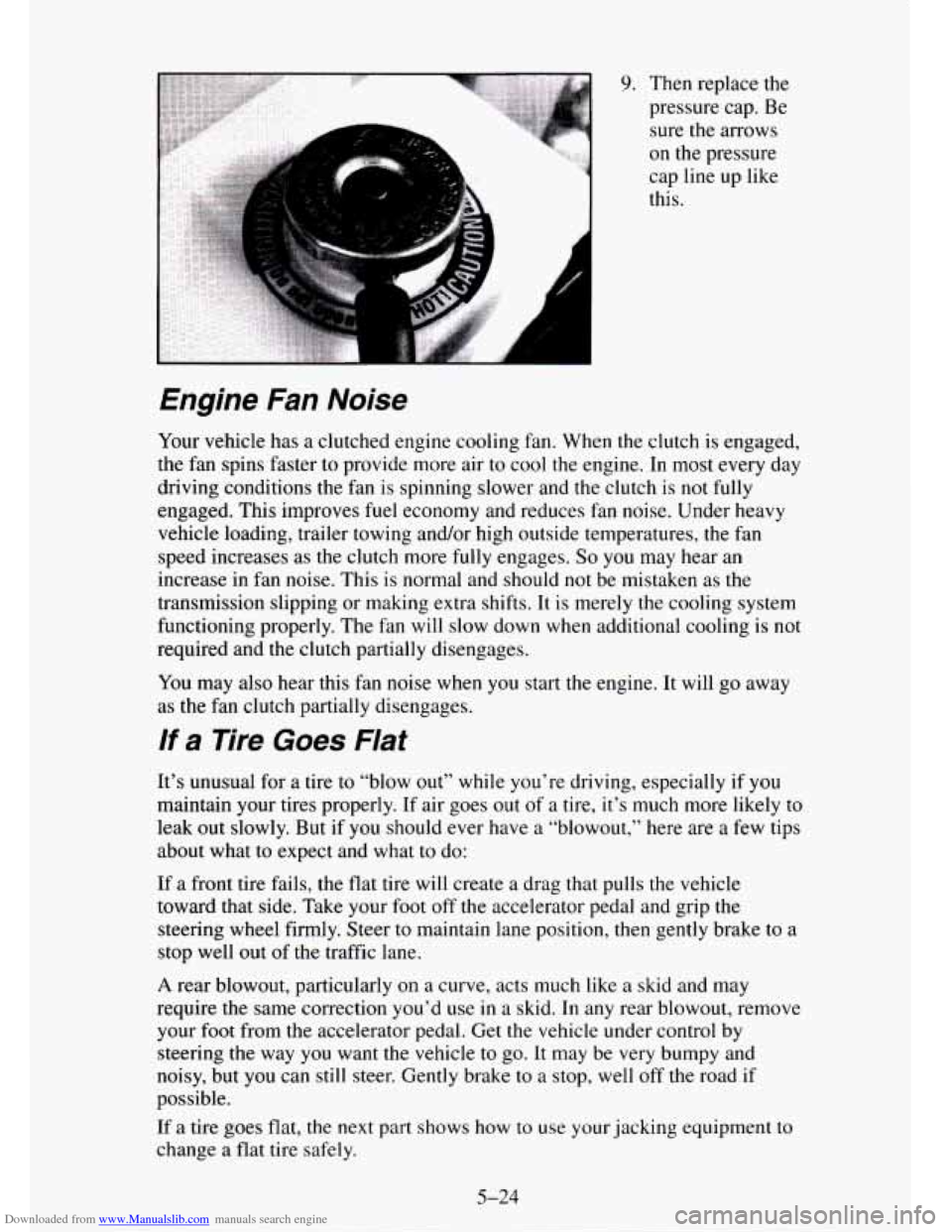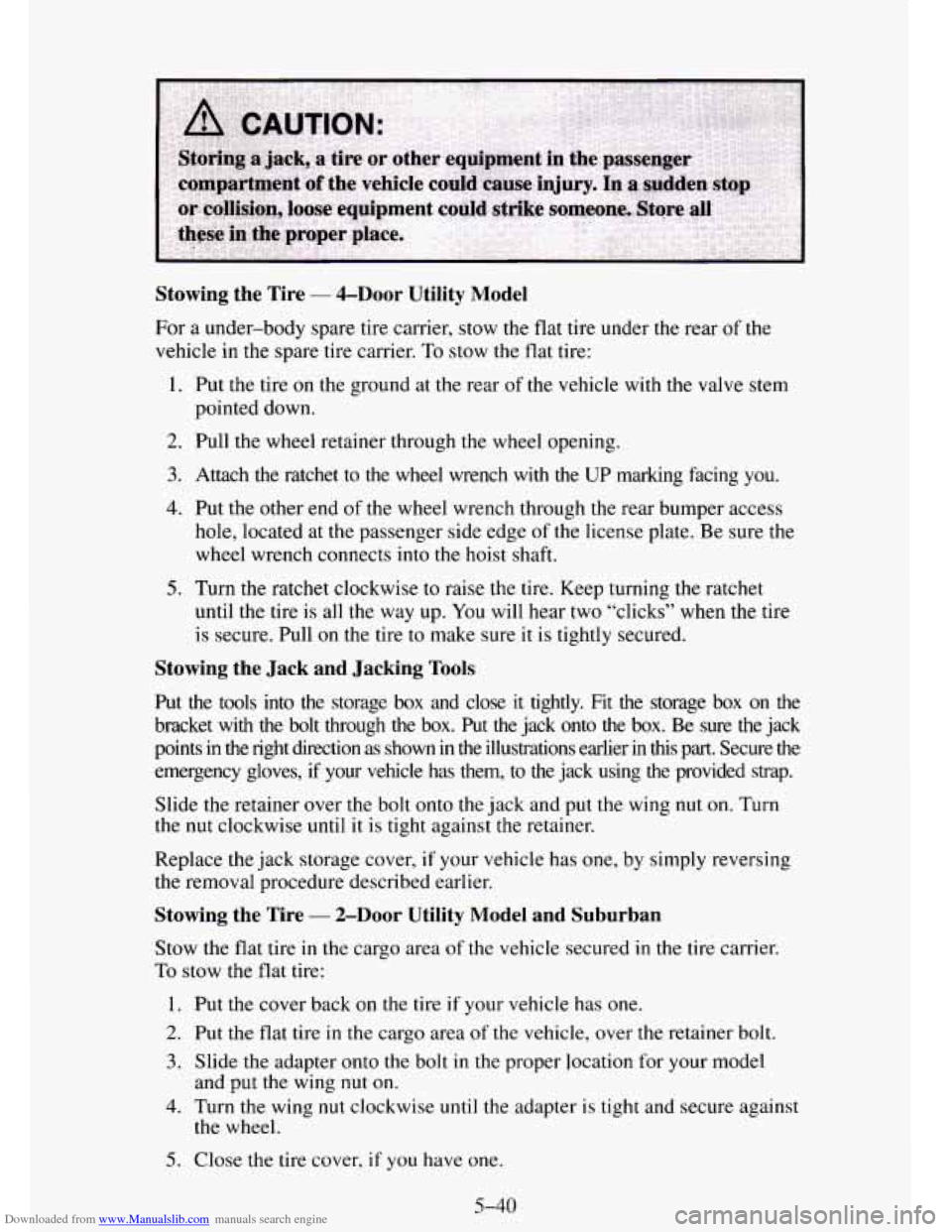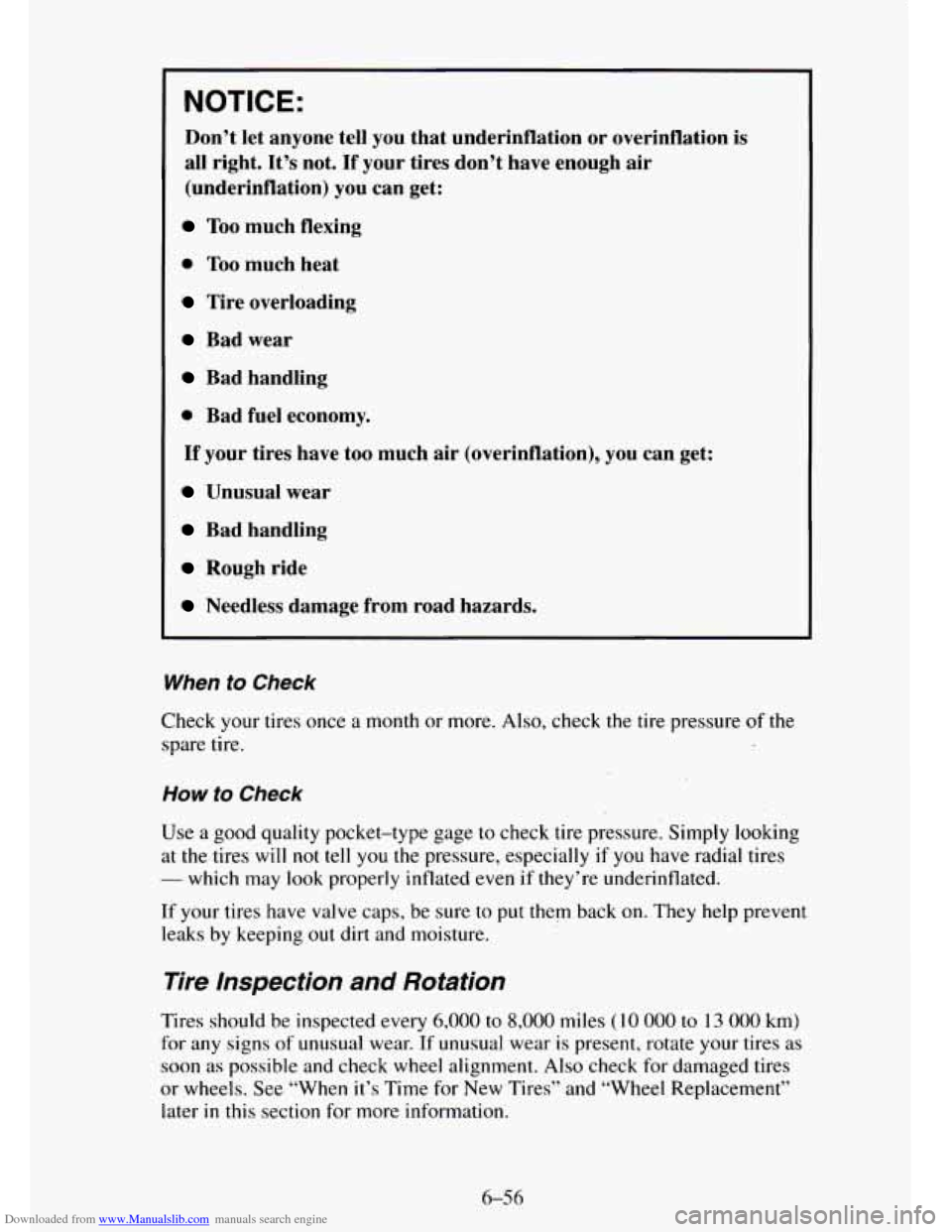Page 257 of 486

Downloaded from www.Manualslib.com manuals search engine h
9. Then replace the
pressure cap. Be
sure the arrows
on the pressure
cap line up like
this.
Engine Fan Noise
Your vehicle has a clutched engine cooling fan. When the clutch is engaged,
the fan spins faster to provide more air to cool the engine. In most every day
driving conditions the fan
is spinning slower and the clutch is not fully
engaged. This improves fuel economy and reduces fan noise. Under heavy
vehicle loading, trailer towing and/or high outside temperatures,
the fan
speed increases as the clutch more
fully engages. So you may hear an
increase in fan noise. This is normal and should not be mistaken as the
transmission slipping
or making extra shifts. It is merely the cooling system
functioning properly. The fan will slow down when additional cooling is not
required and the clutch partially disengages.
You may also hear this fan noise when you start the engine. It will go away
as the fan clutch partially disengages.
If a Tire Goes Flat
It’s unusual for a tire to “blow out” while you’re driving, especially if you
maintain your tires properly. If air goes out of a tire, it’s much more likely to
leak out slowly. But if you should ever have a “blowout,” here are a few tips
about what
to expect and what to do:
If a front tire fails, the flat tire will create a drag that pulls the vehicle
toward that side. Take your foot off the accelerator pedal and grip the
steering wheel firmly. Steer
to maintain lane position, then gently brake to a
stop well out of the traffic lane.
A rear blowout, particularly on a curve, acts much like a skid and may
require the same correction you’d
use in a skid. In any rear blowout, remove
your foot from
the accelerator pedal. Get the vehicle under control by
steering the way
you want the vehicle to go. It may be very bumpy and
noisy, but you can still steer. Gently brake to a stop, well
off the road if
possible.
If a tire goes flat, the next part shows how to use your jacking equipment to
change a flat tire safely.
5-24
Page 258 of 486
Downloaded from www.Manualslib.com manuals search engine Changing a Flat Tire
If a tire goes flat, avoid further tire and wheel damage by driving slowly to a
level place. Turn on your hazard warning flashers.
A. Flat Tire
B . Blocked Tire
The following steps will tell you how to use the jack and change a tire.
The equipment you’ll need is located in the rear cargo area. You’ll also find
your spare tire there.
5-25
Page 267 of 486
Downloaded from www.Manualslib.com manuals search engine Changing the Tire
Start with the jack, the
jack handle and
the
ratchet.
If the flat tire
is on the
rear of the vehicle,
you'll need the jack
handle extensions
also.
Attach the jack handle (and jack handle extension, if needed)
to the jack.
One side of the ratchet has an
UP marking. The other side has a DOWN marking.
With the
UP marking
on the ratchet facing
you, rotate the ratchet
clockwise. That will
lift
the jack head a
little.
Before
you start, put the spare tire near the flat tire. Remove the whee\
l trim and
loosen the wheel nuts. The next part will show
you how to do these things properly.
5-34
Page 269 of 486
Downloaded from www.Manualslib.com manuals search engine If the flat tire is on the rear of the vehicle, put the jack handle extension on
the jack handle.
Position the jack under the vehicle.
I NOTICE:
Raising your vehicle with the jack improperly positioned will
damage the vehicle or may allow the vehicle to fall off the jack.
Be sure to fit the jack lift head into the proper location before
raising your vehicle.
Front Position Rear Position
I
I--
i
f With UP on the ratchet facing you, raise the vehicle by rotating the ratchet r
4 there is enough room for the spare tire to fit.
and
wheel wrench clockwise. Raise
the vehicle far enough off the ground so
5-36
Page 270 of 486
Downloaded from www.Manualslib.com manuals search engine Remove all the wheel
nuts and take
off the
flat tire.
Remove any rust or
dirt from the wheel bolts, mounting surfaces and spare
wheel. Place the spare on the wheel mounting surface.
5-37
Page 273 of 486

Downloaded from www.Manualslib.com manuals search engine Stowing the Tire - &Door Utility Model
For a under-body spare tire carrier, stow the flat tire under the rear of the
vehicle in
the spare tire carrier. To stow the flat tire:
1. Put the tire
on the ground at the rear of the vehicle with the valve stem
2. Pull the wheel retainer through the wheel opening.
pointed
down.
3. Attach the ratchet to the wheel wrench with the UP marking facing you.
4. Put the other end of the wheel wrench through the rear bumper access
hole, located at the passenger side edge of the license plate. Be sure the
wheel wrench connects into the hoist shaft.
5. Turn the ratchet clockwise to raise the tire. Keep turning the ratchet
until the tire
is all the way up. You will hear two “clicks” when the tire
is secure. Pull on the tire to make sure
it is tightly secured.
Stowing the Jack and Jacking Tools
Put the tools into the storage box and close it tightly. Fit the storage box on the
bracket with the bolt through the
box. Put the jack onto the box. Be sure the jack
points in
the right direction as shown in the illustrations earlier in this part. Secure the
emergency gloves, if your vehicle has them, to the jack using the provided strap.
Slide the retainer over the bolt onto the jack and put the wing
nut on. Turn
the nut clockwise until it is tight against the retainer.
Replace the jack storage cover, if your vehicle has one, by simply reversing
the removal procedure described earlier.
Stowing the Tire - 2-Door Utility Model and Suburban
Stow the flat tire in the cargo area of the vehicle secured in the tire carrier.
To stow the flat tire:
1. Put the cover back on the tire
if your vehicle has one.
2. Put the flat tire in the cargo area of the vehicle, over the retainer bolt.
3. Slide the adapter onto the bolt in the proper location for your model
4. Turn the wing nut clockwise until the adapter is tight and secure against
and
put
the wing nut on.
the wheel.
5. Close the tire cover, if you have one.
5-40
Page 332 of 486
Downloaded from www.Manualslib.com manuals search engine Inflation - lire Pressure
The CertificationD’ire label which is on the rear edge of the driver’s door, or
on the incomplete vehicle document in the cab, shows the correct inflation
pressures for your tires, when they’re cold. “Cold” means your vehicle has
been sitting for at least three hours or driven no more than a mile.
You can operate some vehicles at reduced inflation pressures
only when
you’ll be carrying reduced loads. On those vehicles, the minimum cold
inflation pressures for a typical reduced load are printed on the “Improved
Ride Tire Pressure” label located on
the driver’s door. Weigh the vehicle to
find the load on each tire and see the label for the minimum cold inflation
pressures for that load.
6-55
Page 333 of 486

Downloaded from www.Manualslib.com manuals search engine NOTICE:
Don’t let anyone tell you that underinflation or overinflation is
all right. It’s not.
If your tires don’t have enough air
(underinflation) you can get:
Too much flexing
0 Too much heat
Tire overloading
Bad wear
Bad handling
0 Bad fuel economy.
If your tires have too much air (overinflation), you can get:
Unusual wear
Bad handling
Rough ride
Needless damage from road hazards.
When to Check
Check your tires once a month or more. Also, check the tire pressure of the
spare tire.
How to Check
Use a good quality pocket-type gage to check tire pressure. Simply looking
at the tires will not tell you the pressure, especially if you have radial tires
- which may look properly inflated even if they’re underinflated.
If your tires have valve caps, be sure
to put them back on. They help prevent
leaks by keeping
out dirt and moisture.
Tire Inspection and Rotation
Tires should be inspected every 6,000 to 8,000 miles (10 000 to 13 000 km)
for any signs
of unusual wear. If unusual wear is present, rotate your tires as
soon as possible and check wheel alignment. Also check for damaged tires
or wheels. See “When it’s Time for New Tires’’ and “Wheel Replacement”
later
in this section for more information.
6-56